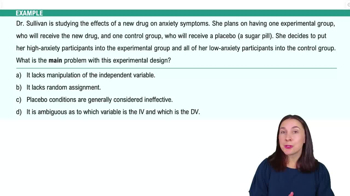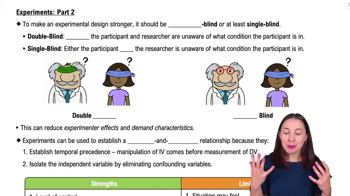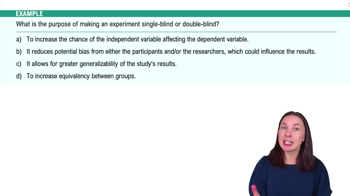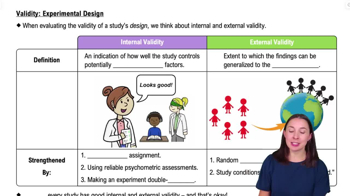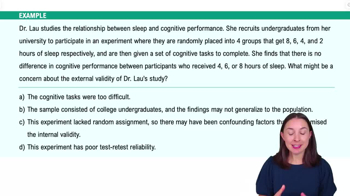Table of contents
- 1. Introduction to Psychology1h 43m
- 2. Psychology Research2h 20m
- 3. Biological Psychology2h 41m
- 4. Sensation and Perception28m
- 5. Consciousness and Sleep32m
- 6. Learning41m
- 7. Memory34m
- 8. Cognition37m
- 9. Emotion and Motivation35m
- 10. Developmental Psychology33m
- 11. Personality48m
- 12. Social Psychology41m
- 13. Stress and Health41m
- 14. Psychological Disorders44m
- 15. Treatment47m
2. Psychology Research
Intro to Research Methods
Struggling with Psychology?
Join thousands of students who trust us to help them ace their exams!Watch the first videoMultiple Choice
The case study is the most effective method of research to use for an investigation of which of the following?
A
Self-esteem differences in males and females
B
Effects of poverty on inner-city youth
C
Physiological changes in people who experience pleasure
D
Dissociative identity disorder in adolescent transsexuals
 Verified step by step guidance
Verified step by step guidance1
Understand the nature of a case study: A case study is an in-depth investigation of a single person, group, event, or community. It is particularly useful for exploring complex issues that cannot be easily quantified.
Identify the characteristics of dissociative identity disorder (DID): DID is a psychological condition characterized by the presence of two or more distinct personality states. It often involves memory gaps and is associated with severe trauma.
Recognize the unique aspects of adolescent transsexuals: Adolescents who identify as transsexual may experience unique psychological challenges, including issues related to identity, acceptance, and mental health.
Consider why a case study is suitable for DID in adolescent transsexuals: Given the complexity and individuality of DID, especially in the context of adolescent transsexuals, a case study allows for a detailed exploration of personal experiences, psychological processes, and social factors.
Evaluate the benefits of using a case study for this investigation: A case study provides rich qualitative data, offering insights into the lived experiences and psychological dynamics of individuals with DID, which can inform treatment approaches and support mechanisms.

 1:46m
1:46mWatch next
Master Roadmap of the Lesson with a bite sized video explanation from Hannah Gordils
Start learningRelated Videos
Related Practice










